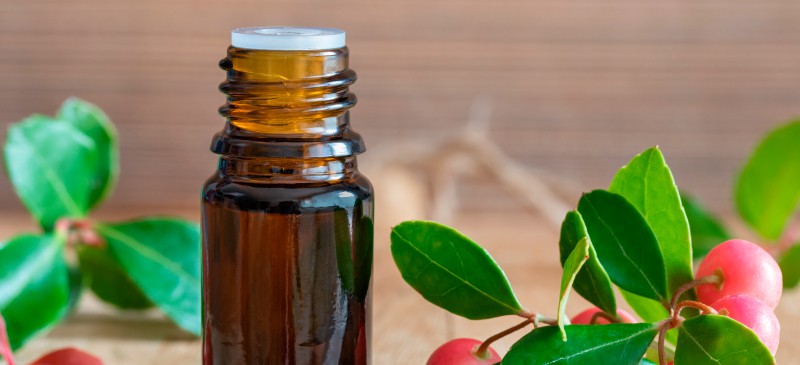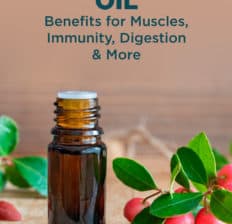This Dr. Axe content is medically reviewed or fact checked to ensure factually accurate information.
With strict editorial sourcing guidelines, we only link to academic research institutions, reputable media sites and, when research is available, medically peer-reviewed studies. Note that the numbers in parentheses (1, 2, etc.) are clickable links to these studies.
The information in our articles is NOT intended to replace a one-on-one relationship with a qualified health care professional and is not intended as medical advice.
This article is based on scientific evidence, written by experts and fact checked by our trained editorial staff. Note that the numbers in parentheses (1, 2, etc.) are clickable links to medically peer-reviewed studies.
Our team includes licensed nutritionists and dietitians, certified health education specialists, as well as certified strength and conditioning specialists, personal trainers and corrective exercise specialists. Our team aims to be not only thorough with its research, but also objective and unbiased.
The information in our articles is NOT intended to replace a one-on-one relationship with a qualified health care professional and is not intended as medical advice.
Wintergreen Oil Benefits for Muscles, Immunity, Digestion & More
January 31, 2022

Wintergreen oil is a beneficial essential oil that’s extracted from the leaves of the Gaultheria procumbens evergreen plant. Once steeped in in warm water, beneficial enzymes within wintergreen leaves called methyl salicylates are released, which are then concentrated into an easy-to-use extract formula using steam distillation.
What is another name for oil of wintergreen? Also sometimes called eastern teaberry, checkerberry or gaultheria oil, wintergreen has been used for centuries by tribes native to North America for its antioxidant and anti-inflammatory effects and more.
Wintergreen Oil Uses
The Gaultheria procumbens wintergreen plant is a member of the Ericaceae plant family. Native to North America, especially cooler parts of the Northeast United States and Canada, wintergreen trees that produce bright red berries can be found growing freely throughout forests.
Research shows that wintergreen oil has the ability to act like a natural analgesic (pain reducer), antiarthritic, antiseptic and astringent. It primarily contains the active ingredient methyl salicylate, which makes up about 85 percent to 99 percent of this essential oil.
Wintergreen is one of the best sources of this inflammation-fighting compound in the world and believed to be one of only several plants that naturally supply enough to form an extract. Birch essential oil also contains methyl salicylate and therefore has similar tension-reducing benefits and uses.
Additionally, wintergreen also contains antioxidants and beneficial ingredients, including:
- guaiadienes
- a-pinene
- myrcene
- delta 3-carene
- limonene
- delta-cadinene
What is wintergreen oil used for?
Some of its uses include helping treat fatigue along with lung, sinus and respiratory illnesses. This oil is naturally an antioxidant, energizing and immune-enhancing, since it lowers inflammation and reduces pain.
Wintergreen is absorbed into skin quickly and acts like a numbing agent, similar to cortisone. It also promotes blood circulation and cools irritation, which is comforting to swollen skin.
You’ll find this oil used as an active ingredient in many topical pain relievers to help ease muscle joint and bone pain. Today, it’s commonly used for reducing other painful conditions, too.
For example, wintergreen is used to help with headaches, chronic nerve pain, PMS symptoms and arthritis. This is because wintergreen naturally contains active constituents that work similarly to aspirin.
The leaves are also beneficial for preventing and treating digestion problems, including stomachaches, cramps, gas and bloating. Because wintergreen oil can help fight inflammation, it’s also effective for helping treat a wide variety of illnesses — everything from respiratory issues like asthma to colds, flu, kidney problems and even heart disease.
Is wintergreen oil the same as peppermint oil?
No, but wintergreen oil naturally has a sweet and fresh scent and smell, very similar to that of peppermint oil. Wintergreen leaves themselves are actually odorless and tasteless, but after a compound called gaultherin present in the leaves is enzymatically hydrolyzed to methyl salicylate, the signature “minty” aroma develops.
Also like peppermint, it has a wide variety of uses in foods, teas, aromatherapy, and household and beauty products.
Wintergreen Essential Oil Benefits
As a primary source of methyl salicylate, a lipophilic liquid that is commonly used as a natural analgesic, counterirritant and rubefacient ingredient in commercially marketed over-the-counter dermatological products, wintergreen has the most researched benefits in regard to pain management and numbing skin and sore muscles.
The effectiveness of the topically applied product depends on the release of the drug and the dosage form. Research shows that methyl salicylate from typical ointment bases and several commercial products works differently on pain, with more concentrated forms (such as pure wintergreen oil) producing the most effects.
Aside from fighting pain, other evidence shows that wintergreen is a powerful fighter of free radical damage and oxidative damage. Researchers have found high levels of inflammation-fighting antioxidants within wintergreen, including phenolics, procyanidins and phenolic acids. Moderate levels of flavonoid antioxidants have also been found.
Comprehensive studies led to the identification of 35 different polyphenols within this plant, with procyanidin A-type trimer, quercetin 3-O-glucuronide, isomers of caffeoylquinic acids and epicatechin the dominant components.
Here’s more about what studies have revealed regarding wintergreen essential oil’s benefits:
1. Muscle Pain Relief
Ever try a pain-relieving muscle rub that smelled like menthol or mint? Chances are the product included peppermint or wintergreen oils because both are considered “counterirritants.”
Studies suggest that wintergreen is capable of reducing inflammatory responses and reliving infection, swelling and pain.
Wintergreen oil works to reduce swelling and irritation that occurs around painful muscle, tissue and joints. Studies show it’s even a plausible alternative therapy to NSAIDs (pain-relieving drugs).
Several drops massaged into the skin is also great for relieving achy joints from arthritis or rheumatism. It’s helpful for treating sore muscles and chronic neck pain, as well as relieving lower back pain.
2. Cold and Flu Treatment
Wintergreen leaves contain an aspirin-like chemical that can help reduce pain, congestion, swelling and fever associated with common illnesses.
To open your nasal passages and breathe more deeply, combine wintergreen and coconut oil together, and then rub them into your chest and upper back just like a store-bought vapor rub.
Other beneficial oils to include in this blend in order to treat or prevent the common cold or flu are eucalyptus, peppermint and bergamot oils.
3. Antibacterial and Antiviral
Gaultheria procumbent extract’s main ingredient methyl salicylate can be metabolized in plant tissues to form salicylic acid, a phytohormone that helps induce plant immunity against microbial pathogens. It also displayed antimicrobial activity against Escherichia coli, Klebsiella pneumoniae and Staphylococcus aureus bacteria that can cause a variety of illnesses, as well as Paederus fuscipes, an insect that can cause dermatitis in humans.
Results from another study showed strong induction of defense markers after treatment with wintergreen oil and reduction in inflammation and infection. Fluorescence measurement of infected tissues revealed that treatments led to a strong reduction (60 percent) of pathogen development and that the efficacy of the G. procumbens essential oil was even similar to the commercially sold product called BION(®).
Since it helps combat bacterial growth, viruses and fungi, use wintergreen around your home or on your body to safely remove dangerous contaminants. You can run some through your dishwasher or laundry machine to kill odor-causing bacteria and molds that can linger. You also can scrub some into your showers and toilet bowls.
4. Digestive Relief
Wintergreen can be used in small doses to increase stomach acid and juices that help improve digestion. It’s considered a natural mild diuretic and increases urine production, which can help cleanse the digestive tract and reduce bloating.
It also has anti-nausea benefits and soothing effects on the gastric lining and colon because of its ability to reduce muscle spasms, making it a natural remedy for nausea.
You can rub a homemade wintergreen oil mixture over your abdomen, stomach and lower back to improve blood flow and prevent cramping or pain.
5. Skin and Hair Treatment
As a natural astringent and antiseptic, when applied directly to the skin with a carrier oil, wintergreen is able to fight inflammation from blemishes and skin disorders.
It’s also helpful for clearing up acne since it can be used to kill germs on the skin. Additionally, some research shows that wintergreen can help other drugs penetrate the skin more easily to help clear up infections and other issues.
You can add one to two drops to your normal face wash or mix it with coconut or jojoba oil to nourish itchy, red, swollen skin. In the shower, use wintergreen oil on your scalp or hair to remove bacteria, greasiness and dandruff while adding a fresh scent.
6. Energizer and Fatigue Fighter
Records show that Native Americans used wintergreen leaves to increase stamina, alertness and endurance during exercise since it can help extend respiratory capacity and treat pain, mucus buildup or inflammation. Try inhaling wintergreen and peppermint oil before workouts to increase concentration and wakefulness.
You can also dab some along with a carrier oil on your neck, chest and wrists to fight symptoms of sleepiness or to help overcome chronic fatigue syndrome. For recovery following a workout, diffusing wintergreen oil with a diffuser or vaporizer can help open up nasal and respiratory passages, improve blood flow, and relive pain associated with muscular, joint or skeletal strains.
7. Soothing Bath Soak
To unwind and relieve muscle tension, applying pure wintergreen oil mixed along with lavender oil to either a warm bath or ice bath serves as a great muscle relaxer.
8. Air Freshener
Since it works as a natural home deodorizer that can help mask foul smells, use wintergreen essential oil around your home to sanitize the air and surfaces of your bathroom and kitchen. Combine several drops with water in a spray bottle, and apply to hard surfaces, appliances, garbage cans and even your toilet bowls.
You can also diffuse this oil using a diffuser to fill bathrooms with a fresh, minty scent or add several drops to some homemade laundry soap for its deodorizing effects.
9. Hunger and Cravings Reducer
The taste and smell of mint can help reduce cravings and signify satiety, which is why many people find it comforting to chew minty gum after a meal or between meals.
If you feel the afternoon munchies coming on or the tendency to overeat, try sniffing wintergreen oil or gargling it in your mouth. You can try applying a couple drops on your temples, chest or clothes, too.
10. Homemade Toothpaste
With its ability to kill odor-causing bacteria and mouth irritants, wintergreen essential oil is a great addition to homemade (or store-bought) toothpastes.
11. Homemade Mouthwash
Wintergreen not only helps naturally freshen your breath, but it can also protect gums and teeth from infection and pain. Add one to two drops to water, and gargle in your mouth for 30–60 seconds before rinsing.
12. Natural Flavor Enhancer
In commercial food and beverage manufacturing, wintergreen is used as a natural flavoring agent in certain minty-tasting foods, candies and teas.
One way to use some at home is to simply add one to two drops to your favorite green smoothie recipes to cut the taste of bitter greens. You can also make homemade mint tea by adding one to two drops to warm water, which improves digestion and helps relieve bloating after a big meal.
Related: Blue Tansy Oil Benefits for Skin & Beyond (+ How to Use)
Risks and Side Effects
Regarding the safety of wintergreen essential oil, research suggests that it’s generally safe to use — however high doses can be toxic and even painful when applied to the skin.
Avoid overconsuming high amounts of wintergreen essential oil or applying it directly to your skin. Use very small quantities, especially if you are new to trying it.
Also be careful to keep it away from your eyes, the mucus membranes inside of your nose, pets and babies.
Because methyl salicylate can be harmful when used on open wounds, internally, on babies or children, and on anyone with allergies, use caution and start slowly.
If you have sensitive skin, there’s a chance you can react badly to mint oils and might experience redness, burning and swelling, so do a small patch test first to test the safety of your reaction. Try testing one to two drops on an area of your skin that isn’t sensitive, such as your feet or calves.
Make sure you can tolerate wintergreen well before using it internally or on larger parts of your body.
Avoid using wintergreen essential oil internally unless you’re working with a professional. Ingesting it can possibly cause side effects for some that include:
- heartburn
- flushing
- mouth sores
- headaches
- rashes
- acid reflux
Some prescription medications and over-the-counter medications can also adversely interact with wintergreen when it’s consumed, so speak with your doctor if you take any digestive or asthma medications, blood thinners, pain medication or anticoagulants.
How to Use (Recipes)
You’ll always get the most benefits from essential oils when they’re 100 percent pure, organic and therapeutic-grade. Pure wintergreen essential oil should have a pale yellow or pinkish yellow color, so steer clear of artificially dyed green or blue oils.
Look for wintergreen oil that smells strong and pungent but not unpleasant or sour.
Here are some ideas for how to use wintergreen oil:
Aromatically: In your home, use a diffuser or vaporizer to distribute the clean smell and antiseptic properties of wintergreen throughout the air. You can always inhale wintergreen directly from the bottle.
Internally: Although leaves from wintergreen plants are edible, it’s not recommended to use concentrated wintergreen essential oil internally since this can potentially be toxic. Due to high levels of very powerful methyl salicylate, some authorities worry about possible interactions of consuming wintergreen, especially in pregnant women or anyone with heart or digestive issues.
Some health care practitioners do use wintergreen as an internal supplement, but it’s best to do so carefully under supervision to avoid safety concerns caused by impure products. Many people have reported no unwanted side effects when consuming it, but each person is different.
When working with a professional, you might be directed to take therapeutic-grade wintergreen oil as a dietary supplement by adding one to two drops to warm water, a smoothie or green juice.
Topically: It’s not recommended to use pure concentrated wintergreen essential oil directly on your skin without first diluting it with a safe carrier oil. Use a small amount to start, just one to two drops, and mix it into coconut, olive, almond or jojoba oil before rubbing into skin and massaging into muscles.
Keep in mind that a very little bit of wintergreen and peppermint oils goes a long way, so using more will not result in better results in this case and can actually cause irritation.
Try using wintergreen essential oil in these simple and effective homemade recipes:
Conclusion
- The Gaultheria procumbens wintergreen plant is a member of the Ericaceae plant family and is native to North America.
- This plant contains high amounts of antioxidants and anti-inflammatory compounds that give it the natural ability to fight, pain, swelling, infection and oxidative stress.
- Other wintergreen essential oil benefits include supporting digestion, clearing skin irritation, improving alertness and senses, and treating colds, fevers, infections and the flu.
- Is wintergreen the same as peppermint? No, these two oils come from two different plants, but they have similar cooling effects and are often used in the same ways, such as to lower pain.
- While this is generally a safe oil to use topically or aromatically in small amounts, there are safety concern when using too much or ingesting it. Don’t take it internally (unless working with a doctor), and use only one to two drops at a time mixed with a carrier oil.









